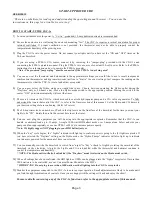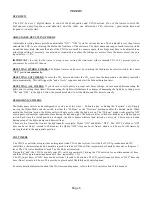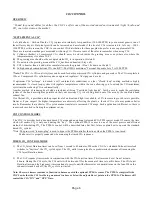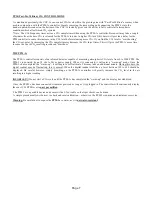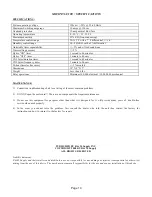
Page 3
START-UP PROCEDURE
OVERVIEW
“There is no substitute for reading and understanding the operating manual however... You can use the
instructions on this page for a trouble -free start-up”.
HOW TO START-UP THE CGC-1e
1)
Locate a suitable source for power. A “3-wire”, grounded, 15-amp dedicated circuit is recommended.
2)
Secure the enclosure to a wall using the enclosed mounting “feet”. The CGC-1e requires a vertical orientation for proper
internal ventilation. If proper ventilation is not provided, the thermostat may not be able to properly control the
temperature & humidity of the growing area.
3)
Plug the CGC-1e into the power source. Do not connect your lights until you have set the “ON and “OFF” times on the
24-hour timeclock.
4)
If you are using a PPM-1c CO
2
sensor, connect it by removing the “jumper-plug” provided with the CGC-1e and
connecting the PPM-1c quick-disconnect. Plug the PPM-1c into a source of constant 120-volt power. Refer to the PPM-1c
instructions for information on how to operate the PPM-1c properly.
* Note: The pre-wired “jumper plug” must be connected if the PPM-1c is not being used!
5)
You can now set the thermostat and de-humistat to the approximate settings you would like to use. A small, inexpensive
combination thermometer and hygrometer works just fine to “dial in” the exact settings. Just compare the reading on the
thermometer to what the CGC-1e is set at and adjust as required.
6)
You can now select the Hydro mode you would like to use. Choose between operating the Hydro outlet during the
“Daytime” only or, 24-hours a day. Move the Hydro mode switch to the appropriate position. Moving the switch to the
center “OFF” position momentarily will reset the timer.
7)
There are 4 timers on the CGC-1e, which are used to control a hydroponics pump and a CO
2
valve or generator. To fully
understand the timers that control the CGC-1e, refer to the Timers section of this manual. Set the Hydro and CO
2
timers to
your desired settings before continuing. (Refer to Timers)
8)
The 24-hour timeclock can now be set. Push in the trip levers on the front face of the timer dial for the time you want your
lights to be “ON”. Rotate the dial to the current time to set the timer.
9)
You can now plug the equipment you will be using into the appropriate receptacles. Remember that the CGC-1e can
handle a combined load up to 15-amps. A single 1000-watt HID ballast needs over 9-amps alone. Select and size your
pumps and fans appropriately or use our UPM-1 or MLCs to increase power capacity.
*Note: We highly suggest NOT plugging in your HID ballast just yet.
10)
When the “day” cycle begins, the “Lights” indicator will light up to confirm power is going to the (2) light receptacles. If
you have selected the “Daytime” setting on the Hydro mode, the “Hydro Pumps” indicator will also light up to indicate
your pump is powered for the amount of time you selected
11)
You can manually override the timeclock to switch from “night” to “day” or back to Night by rotating the outer dial of the
timeclock slowly clockwise. At night, the Lights and CO
2
are disabled while the thermostat and humistat continue to
control the temperature and humidity.
* NOTE: The Hydro outlet will also be disabled if the “Daytime” mode is selected on the Hydro mode switch.
12)
When all settings have been confirmed, the HID lights or UPMs can be plugged into the “Lights” receptacles. If more than
1000 watts are to be controlled, use our Universal Power Modules or the MLCs.
* IMPORTANT: Do not plug in more than 1000 watts worth of lighting into the CGC-1e receptacles.
13)
Monitor the equipment connected to the CGC-1e to ensure proper operation. Small adjustments are likely to be made until
you find the right combination of controls. Once you are happy with the settings sit back and enjoy the show!
For more details concerning any of the CGC-1e functions, refer to the appropriate section of this manual.



